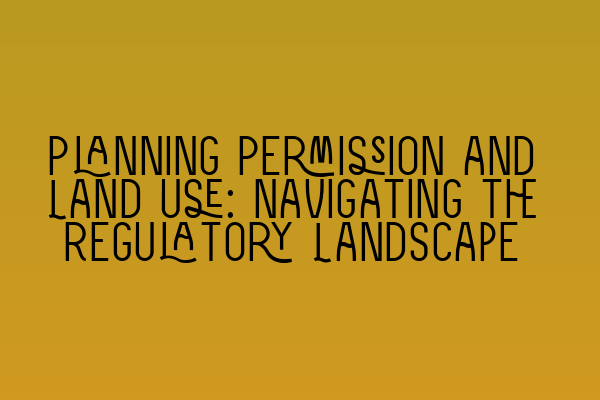Planning Permission and Land Use: Navigating the Regulatory Landscape
Introduction
When it comes to property development, planning permission and land use regulations play a crucial role in determining what can be built and where. Navigating this complex regulatory landscape can be challenging, but with the right knowledge and guidance, you can ensure a smooth and successful development process. In this blog post, we will delve into the key aspects of planning permission and land use, providing you with valuable insights to help you make informed decisions and comply with the relevant regulations.
Understanding Planning Permission
Planning permission is the legal confirmation required from the local planning authority to carry out certain types of development on a property. This permission ensures that the proposed development aligns with the local development plan, building regulations, and other relevant policies.
Getting planning permission is a critical step in any property development project. Without it, you risk facing legal consequences, hefty fines, and even having to demolish any unauthorized development. Therefore, it is crucial to understand the planning permission process and engage with the local planning authority at an early stage.
The Planning Permission Process
The planning permission process involves several stages, including:
1. Pre-application: In this initial stage, it is advisable to engage with planning consultants who can help you assess the feasibility of your development plans. They will guide you through the complexities of local planning policies and advise on any potential hurdles that may arise.
2. Submission of application: Once you have determined the viability of your development plans, you can proceed with submitting a planning application to the local planning authority. This application should include relevant documents, plans, and details of the proposed development.
3. Application review: The local planning authority will review your application, considering factors such as the impact on the local environment, infrastructure, and community. They may also consult with relevant stakeholders or request additional information during this stage.
4. Decision-making: After careful review, the local planning authority will make a decision on your application. This decision can include granting planning permission, imposing conditions, or rejecting the application. It is essential to review any conditions attached to the permission and ensure compliance throughout the development process.
5. Appeals: If your planning application is rejected or if you disagree with any conditions imposed, you have the right to appeal the decision. The appeals process can involve an appeal to the local planning authority or a higher authority, such as the Planning Inspectorate.
Understanding Land Use Regulations
Land use regulations govern how land and property can be utilized in different areas. These regulations aim to control and manage the development of land in order to protect the environment, preserve heritage, and ensure the well-being of local communities. It is essential to be aware of the specific regulations applicable to your property to avoid any legal complications in the future.
Common Land Use Regulations
1. Zoning: Many countries and regions have zoning regulations that divide land into different zones or areas with specific permitted uses. These zones may include residential, commercial, industrial, and agricultural areas. Understanding the zoning regulations in your area is crucial to determine what types of development are permissible on your property.
2. Conservation Areas: Conservation areas are designated areas that require special protection due to their architectural, historic, or environmental significance. If your property falls within a conservation area, you may be subject to additional planning restrictions to preserve the area’s unique character.
3. Listed Buildings: Listed buildings are structures that are of historical or architectural importance and are protected by law. Any changes or alterations to listed buildings typically require planning permission and must be carried out in a manner that preserves the building’s special architectural or historic features.
4. Green Belt and Areas of Outstanding Natural Beauty (AONB): Green belt areas and AONBs are designated to protect the countryside from excessive urbanization. Development in these areas is typically restricted, and any proposed development must demonstrate exceptional circumstances to obtain planning permission.
Conclusion
Navigating the regulatory landscape of planning permission and land use is crucial for property developers and investors. Compliance with these regulations not only ensures a smooth development process but also protects the environment, heritage, and local communities. By understanding the planning permission process and familiarizing yourself with the relevant land use regulations, you can make informed decisions and avoid potential legal consequences.
At SQE Property Law & Land Law, we have a team of experienced solicitors who can guide you through the intricacies of planning permission and land use regulations. Contact us today to discuss your property development plans, or check out our related articles for more valuable insights:
– SQE 1 Practice Exam Questions
– SQE 1 Practice Mocks FLK1 FLK2
– SQE 2 Preparation Courses
– SQE 1 Preparation Courses
– SRA SQE Exam Dates
Disclaimer: The information provided in this blog post is for general informational purposes only and should not be construed as legal advice. For specific advice regarding your property development project, consult with a qualified solicitor.
